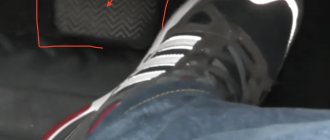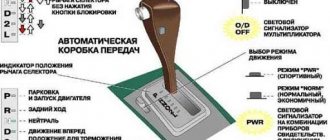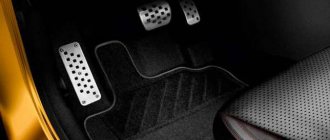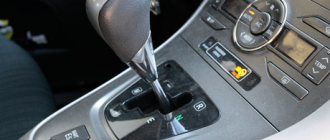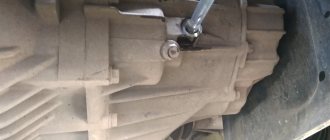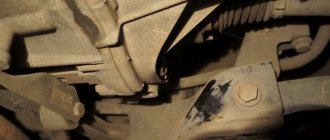It’s not difficult to learn how to drive off with a manual after an automatic. Novice drivers are often simply afraid to drive such a car, because it requires a special attitude.
In an automatic transmission, the entire process of switching the transmission is carried out by a computer, while in a manual transmission, control of the car falls entirely on the driver.
In this article we will try to help you master a car with a manual transmission. We'll tell you about ways to get moving with a manual transmission, step by step for dummies we'll analyze all the stages of starting to move a car with this gearbox. Let's consider the nuances associated with switching speeds, as well as other useful topics. But first, let's talk about the advantages and reasons for the popularity of this transmission.
How to learn how to properly start with a manual transmission
The essence of the problem for beginners usually lies in the fact that driving instructors teach them to start only with the clutch itself, without using the accelerator pedal.
In practice, such a technique quickly discredits itself, since its relevance ends where regular road traffic begins with the participation of a huge number of other cars. In addition, the clutch on different cars can be configured differently. If this approach works on an empty, flat, strictly horizontal road, then when driving up a hill or at a busy intersection, additional skills are simply needed.
How to start with a manual transmission: Video tutorial
How to get moving without stalling: step-by-step instructions
You need to start driving by pressing the clutch pedal all the way as usual. At the same time, the manual transmission lever is shifted to first gear. Once the car starts moving, you cannot remove your foot from the clutch. This is permissible only after sufficient acceleration - approximately after 2-3 meters. If the car's engine is weak, then during such a maneuver it will stall. To avoid this, you will have to connect the gas pedal.
Difficulties may arise when climbing a hill or after stopping at a traffic light. In the first case, it is important to prevent the car from inadvertently rolling away by using the brake pedal. In the second, the main thing is not to drop the clutch, otherwise the engine will stop. When starting, you can also apply the handbrake.
Start of movement on mechanics
How to start with a manual transmission correctly
How to start with a manual transmission – Starting to move.
Before moving away, carefully, through the glass windows, and not just in the mirrors, you need to look to the sides, forward and backward, in order to avoid an accident with an unnoticed moving or standing obstacle. Then you need to signal with a turn signal that movement is starting. Then you need to depress the clutch pedal all the way, and move the gearbox lever to the 1st gear position; to do this, the lever must be moved to the left and forward. Without removing your feet from the clutch pedal, you should lower the handbrake lever and put your hand on the steering wheel. Very slowly release the clutch pedal, while listening to how the engine works. As soon as you hear that the crankshaft speed begins to decrease, you should hold the pedal a little in this position, simultaneously pressing the gas pedal. The car will start moving, and you need to calmly release the clutch without finishing pressing the gas pedal. How to start with a manual transmission - Mistakes. Many of the beginners do not fully unscrew the clutch pedal, which creates some problems when jerking into 1st gear. Periodically, this process is accompanied by a grinding noise coming from the gearbox. This is very dangerous and may damage it. Incorrectly pressing the gas pedal is also one of the mistakes beginners make. An excessively early increase in the fuel supply leads to the engine roaring, but the car does not move because the clutch has not yet been fully released. An excessively late increase in feed leads to the fact that the car simply stalls, moreover, making a jerk forward. And this can already become a reason for the clutch to become out of working condition. If you release the clutch pedal too quickly after pressing the gas pedal, the car jerks and begins to stall, which will naturally lead to damage to the clutch. Usually, the driver, as a rule, correctly determines the moment when it is necessary to start increasing the fuel supply, but if, instead of releasing the clutch gradually, he quickly releases the pedal, such actions will probably have bad results for the clutch. The next mistake is an excessively sharp increase in the fuel supply. This leads to the fact that the car, instead of moving off smoothly, quickly and periodically with squealing tires, flies away. How to move off manually - Conclusion. The process of starting to move the car, which at first seems very easy, actually leads to some difficulties for many beginners. Almost all beginners learn to drive a car, it jerks and stalls. Although this only applies to those who are learning to drive a manual car. With automatic transmissions this process is much simpler. In this case, in order to get moving, it is enough to simply move the gear shift lever to the driving state, usually this is position D, but not always, and then gradually increase the fuel supply and press the gas pedal.
Bad habits when driving a manual car
Hand on the gearshift knob
This bad habit is familiar to all motorists without exception, as well as to those who try to imitate Dominic Torreto from The Fast and the Furious. It doesn’t matter whether you drive a manual or an automatic. You can always catch yourself wanting to take one of your hands off the steering wheel and put it on the gearshift lever.
And if in the case of an automatic transmission the driver risks only accidentally engaging neutral, then in a manual transmission, prolonged pressure on the lever harms the components of the box, in particular we are talking about forks and gearshift clutches. Yes, wear and tear will accelerate non-radically, but the service visit will become a little closer.
Under-depressed clutch
It is not uncommon to hear an unpleasant metallic crunch when changing gears. If the car is technically in perfect working order, then there is only one reason for the sound - the clutch pedal is not fully pressed. In such a situation, the gears in the gearbox continue to rotate and engaging a new gear is painful.
Why the car won't start - in a review from TopGears
In addition to the annoying sound, frequent repetition of this error can lead to the death of the synchronizer teeth. The gearbox will work, but the shifts will become unclear, and the unpleasant sound will not go away even with the clutch pedal fully depressed.
Engaging reverse gear while driving
This situation can especially often happen in a hurry. This, as in the previous paragraph, negatively affects the gear teeth, licking them off only on one side, which slowly renders the mechanism unusable.
In such a situation, a pronounced grinding noise is heard, and the switching itself is very difficult to do. If this error is constantly repeated, the rear stage will engage more and more poorly until it completely breaks down.
Critical braking with motor
Engine braking is a technique for reducing speed without using the braking system, which almost everyone who has ever driven a manual transmission knows about. As a rule, it should be used on serpentines in the mountains and, of course, on long descents, when there is a risk of brake overheating. There are, of course, nuances.
For example, remember that using engine deceleration will not illuminate your vehicle's brake lights, and drivers behind you may not be prepared for this eventuality.
It is also extremely important to engage exactly the gear that will provide the most effective braking without unpleasant consequences such as short-term blocking of the drive wheels and gearbox breakdown and engine damage. This is possible if, while moving at high speed, you suddenly decide to engage first or second gear.
Changing gear without pressing the clutch
This type of driving is common among beginners who, while gaining skills, make a lot of small mistakes. Those who have studied and driven a car with an automatic transmission do not always squeeze the clutch.
Shifting without pressing the clutch pedal puts dangerous stress on the transmission. As a result, gear teeth may “lick” or break. In this case, the box quickly fails.
Downshift two steps at once
When using a manual transmission, drivers must have an idea of what speed to change gears at. Indeed, if the speed turns out to be higher than the transmission can bear and immediately after releasing the clutch, strong engine braking will occur.
This, in turn, can lead to malfunction of the discs and gearbox, as well as the timing belt. This situation is especially dangerous in winter, when the drive wheels instantly slow down with such engine braking, which leads to a dangerous departure from the trajectory.
How to change gears in a car with a manual transmission
How to reverse with a manual transmission and drive with a manual transmission
Drivers who have a car with a manual transmission will have to gain a little skill so that the process of changing gears is smooth and painless for the car and passengers. Let's look at how to shift the gearbox in this case.
Firstly, it is immediately worth noting that the techniques for switching from a lower gear to a higher gear (for example, from first to second) during acceleration and from upshifting to a lower gear (for example, from fourth to third) differ significantly. You need to remember this until your skills reach automaticity.
Secondly, you also need to take into account the terrain of the route on which the car is located. When driving uphill, the gearshift lever shift speed should be much faster than when driving on a flat road. When turning, you should not shift at all, as if you are inexperienced, this can lead to the car skidding.
At what speed should you shift gears?
If the car is equipped with a device such as a tachometer, which shows engine revolutions per minute, then gear shifting can initially be coordinated with its readings. It is believed that this should be done at engine speeds from 2500 to 3500 per minute.
If there is no tachometer in the car, then you can feel the switching moment by pressing the gas pedal, at first we feel that the car is picking up speed and the engine speed is also increasing, but after a while the speed stops picking up, and the speed continues to increase, so the time we need has arrived moment of switching, because if you continue to press the gas further, the engine will roar loudly, and the car will not go faster.
Preparation and switching
So, let's imagine that you have already set off and are driving along a straight, flat road at first speed. Before you start shifting, you need to put your right hand (for left-hand drive cars) on the gearshift lever, put your left foot on the clutch pedal and get ready to shift when you consider it necessary.
So, let's imagine that you have already set off and are driving along a straight, flat road at first speed. Before you start shifting, you need to put your right hand (for left-hand drive cars) on the gearshift lever, put your left foot on the clutch pedal and get ready to shift when you consider it necessary.
When the moment comes, immediately press the clutch pedal with your left foot and at the same time release the gas. As soon as the clutch pedal is pressed, with your right hand we turn off first gear (after all, we were driving in it) and immediately move the lever to the second speed position, after which we smoothly release the clutch and, listening to the engine, maintain it at the power necessary for movement, pressing on the gas. This whole procedure should take you about two to three seconds, after which the clutch pedal should be released and the car should move faster than in first gear.
Similarly, we switch to the next higher gears
You need to hone all these manipulations so that everything happens “automatically”, because when you are moving in a stream of cars you need to maintain the required speed limit and at the same time not distract attention from the road to extraneous things
way: swing
If you already have minimal experience, you have become familiar with the right and left pedals and have learned how to start correctly, you can move on to the next level - the so-called “swing” or “scissors”. This method is used by most experienced drivers, and it happens “automatically”.
Starting position: gearbox in neutral, car started.
- We depress the clutch with our left foot and engage the gear.
- We place our right foot on the gas, but do not press it.
- We smoothly release our left foot, and feeling the vibration, we begin to increase the engine speed.
If everything is done correctly, the car will start moving.
» data-lazy-type=»iframe» src=»data:image/gif;base64,R0lGODlhAQABAIAAAAAAAP///yH5BAEAAAAALAAAAAABAAEAAAIBRAA7″>
Start driving
Manual driving rules for beginners
Driving a car with a manual transmission begins with mastering the layout of the gears. In order to switch automatically while the vehicle is moving, do not look closely at the shift lever. They go through the initial stage of training with the engine turned off, it’s safer. Remembering the location of the gears is worth sequentially switching the gearbox lever to different positions. The gear layout is marked on the lever. There is no diagram - consult with the drivers, let them tell you the location of each gear. The middle position (the lever moves freely) is neutral.
Having learned how to shift the gearbox, proceed to the next stage: combine changing gears with pressing the clutch and gas pedals. Place the gearbox handle in the neutral position, having previously depressed the clutch, start the engine and warm it up to operating temperature. If the ambient temperature is below zero: while warming up the engine, press the clutch pedal. This will speed up the heating of the oil in the box. Start the car with the gear off so that the car does not start moving uncontrollably. When starting to drive, slowly release the clutch pedal and simultaneously press the gas pedal. To prevent the car from stalling, the engine needs to gain speed. Increase them by pressing the gas (lightly), so as not to provoke a sharp start. Do not press the clutch pedal for more than 2 seconds while changing gears. Learn to shift gears using the tachometer or listen to the powertrain. If the engine speed is low and the car does not pick up the desired speed, then switch to neutral, then switch to a lower gear.
If the engine speed is very high, engage a higher gear. The tachometer readings will help you focus on engine speed. To learn how to drive backwards, master reverse speed control. You can turn it on by stopping the car. If the lever is shifted incorrectly, the gear will jump out. At reverse speed, the transmission picks up speed very quickly. Therefore, driving it for a long time is dangerous.
We recommend watching a video about braking with a manual transmission:
Getting to know the gearbox
Most practical drivers have never seen an open gearbox and do not imagine the complexity of the mechanism. This is not necessary for proper driving. It is enough to know that the complex system of gearbox gears transmits the rotation of the car engine shaft to the wheel axles, providing movement. The speed of the car depends on the diameter of the transmission gears, the number of teeth, and the gear ratio.
The manual transmission gear system transmits the rotation of the engine shaft to the wheel axles, providing movement
In practice, this means that at the same speed of the engine shaft, the car moves at different speeds. For example, at three thousand revolutions per minute, a car can travel at a speed of 45 or 105 km/h. To optimize engine mode, there is a gearbox. In manual transmissions, the gear shifting process is controlled by the driver, in automatic transmissions - electronically.
For a smooth transition to the next gears, manual transmissions are equipped with a clutch. The engine crankshaft rotates continuously and cannot be stopped to shift. When you press the clutch pedal, the gears of the gearbox are separated, when released they come into close contact and begin to work.
Practical acquaintance of an experienced driver with the gearbox of an unfamiliar car begins with checking the gearbox movements. Most production cars are equipped with a five-speed manual transmission. In fact, there are six gears (the classification does not take into account reverse). Old models with a four-speed gearbox are quite rare; pickup trucks, such expensive models as the Bugatti Veyron and BMW M5, are equipped with six-speed and seven-speed gearboxes.
The gearbox of used imported cars may have a non-standard gear shift pattern. Most often this concerns reverse; it can be engaged in the extreme left position (to the left of second gear), equipped with a special lever (ring), working only when it is lifted or pressed. You need to familiarize yourself with these features with the engine not running and the car at a standstill. To do this, without turning on the engine, you need to depress the clutch and try all the gears in turn.
Such familiarization is important for understanding the length of the lever stroke (long or short), the stroke of the clutch pedal (although the place where the clutch “grabs” can only be determined in motion). Any gearbox is individual, especially for worn-out cars
The car owner knows these features well, for example, “third gear needs to be pushed harder,” “fourth gear needs to be pressed to the right edge.” The rule for serviceable gearboxes should be easy engagement “to place” on the first try, the same (effortless) switching off, no crunching or grinding of gears
Any gearbox is individual, especially for worn-out cars. The car owner knows these features well, for example, “third gear needs to be pushed harder,” “fourth gear needs to be pressed to the right edge.” The rule for serviceable gearboxes should be easy engagement “to place” on the first try, the same (effortless) switching off, no crunching or grinding of gears.
Advantages of manual transmission
By default, driving a car of any category with a manual transmission has the following advantages:
- the cost of a car is cheaper with a similar configuration;
- traffic safety increases, since in an emergency you can brake with the engine;
- the user independently chooses the driving style;
- the operating budget of a manual is significantly lower than that of an automatic;
- the mechanics can be started “from the pusher” downhill with a discharged battery;
- design and maintenance are as simple as possible, there are no expensive consumables;
- Maximum efficiency, long-distance towing is allowed;
- for ice, dirt roads and mud this is the best option;
- acceleration dynamics are higher, and the weight of the unit is less than that of an automatic transmission.
A car with an automatic transmission is difficult to tow
Mistakes made by beginners when shifting gears
With the help of this pedal, the mechanical process of mechanically disconnecting the engine drive from the wheel drive takes place. Therefore, on a manual transmission, when switching from low to high speed or vice versa, you need to depress the clutch pedal. If you do not learn how to operate this mechanism correctly, you are not only guaranteed to have your car repaired as quickly as possible, but you also increase the likelihood of getting into a traffic accident.
The main mistakes that most often occur when changing gears among beginners can be called the following:
Over-throttle or dive of the car (short-term engine braking) at the moment of releasing the gas pedal and pressing the clutch. This happens because the student releases the gas faster than he squeezes the clutch in case of a dive. Or, on the contrary, he quickly presses the clutch, but does not release the gas pedal, resulting in over-throttle. Shift the emphasis to the hand with which the student holds the steering wheel (pulls the steering wheel to the left) at the moment of engaging the gear. This habit can easily lead you astray. Incorrect operation of the gearbox lever. The gear is engaged not according to the scheme, but diagonally. This leads to the fact that a completely different speed is switched on instead of the desired gear. For example, instead of first gear, third gear is engaged, and instead of second gear, fourth gear is engaged. You should know the location of each gear before you get behind the wheel for the first time. It’s better to practice changing gears with the car not running and exactly according to the diagram
In this way, various problems, such as those associated with incorrect shifting while driving, can be avoided. Also, novice drivers often distract their attention to the gear lever when shifting, instead of watching the road. This is strictly prohibited and may cause an accident, try not to look at it. As practice shows, choosing the moment for subsequent switching or not knowing which gear to engage at a particular speed also becomes difficult.
We'll talk about this in more detail below.
You can also learn about the mistakes of novice drivers from the following video:
Start with clutch locked
To move the car using this method, you only need to slightly modify the procedure described in the previous version. When you release the clutch pedal and vibration appears, you need to fix your foot in one position and at the same time begin to loosen the brake. When the car starts moving, you should smoothly release the clutch and add gas.
The appearance of specific vibration in the engine is due to the fact that the clutch discs grab, and the load on the transmission and engine increases sharply. The movement of the car that has started is actually held back by one brake. If the maneuver is performed correctly, the car will remain in place or start moving forward, but will definitely not roll back.
General recommendations
Driving a car with a manual transmission is a labor-intensive process, more difficult than driving with an automatic transmission. Having acquired certain skills and experience, the driver has mastered the principle of operation of manual gearboxes, he feels the car, he understands the connection between speeds and the gearbox.
Useful tips:
- You cannot drive in neutral gear; when the car rolls down a slope, the wheels may lock and you may lose control of the steering. It is unsafe to drive on a slippery road.
- When approaching a traffic light, apply the engine brakes, then shift into a lower gear.
- When driving the car, do not frequently depress the clutch - this will damage the release bearing; use the neutral position of the gearbox lever.
- In winter, do not leave the car on the handbrake: the brake pads will freeze and the car will not move.
- When driving over a speed bump, reduce your speed away from it, and sharply release the brake just before the obstacle.
- When driving the vehicle at a stable speed, do not keep your left foot over the clutch pedal. This leads to muscle strain and involuntary pressing of the clutch, which can lead to its breakdown.
- The engine operation is unstable: press the clutch and wait until the engine starts working correctly.
- Press the clutch to the floor before changing gear.
- Knowing that you will need to park your car on a slope, take a brick on the road, place it under the car’s wheel and the car will not roll down.
- Before engaging reverse gear, stop the vehicle.
- Novice drivers rely on the tachometer when changing gears. You need to drive a car taking into account possible engine damage due to high engine speeds.
- The car has stalled, you don’t need to start it right away. Wait a minute to prevent the starter from overheating and draining the battery.
You have received your license, but you are not confident in driving correctly, choose roads that are not congested with cars and practice driving. You will get used to the car and feel confident.
Driving a manual car requires the patience and strength of a novice driver. Confused on the road and nervous, pull the car to the side of the road, turn on the emergency lights, calm down and continue driving.
A novice driver needs to ignore the boorish attitude of other drivers (ridiculing and cutting off cars marked with a student sign). By getting into debates with boors while driving, you risk becoming involved in an accident; after the accident, you will have to repair the body of your own car. A novice driver driving a car needs:
- Be collected (no panic);
- Be polite towards other road users;
- Listen to the operation of the engine;
- Take a closer look at the tachometer;
- Look in the mirrors.
Time will pass and the beginner will learn to use the manual transmission correctly. Proper driving allows you to save fuel, plus it gives you a chance to feel the power of the engine.
Some tips for safe driving
Pulling away without jerking or suddenly stopping the engine is an indicator of the driver’s professionalism. It’s not difficult to learn this, the main thing is to be patient and create the right conditions:
- for training, choose race tracks or empty roads with no traffic;
- move onto roads with heavy traffic gradually;
- Do not neglect the help of specialists; if necessary, take several practical lessons at a driving school.
When driving a car, all maneuvers must be leisurely and deliberate. A manual car is in many ways superior to an automatic car, despite the fact that the demand for computerized cars is growing rapidly every year. All you need for a comfortable ride is to learn to feel the car and remember the rules of the road.
A little theory
In this article we will look at how to get started in a car with a manual transmission. It is on such cars that problems arise with starting to move, which cannot be said about cars with automatic transmission.
But first, you need to at least roughly understand how exactly the mechanism that allows you to set the car in motion works.
Transmission
A transmission is a part of a car that transmits torque from the engine to the wheels. It helps to make changes in the direction and speed of the car. Also called a gearbox. It is also used to change gears. The leading role in the gearbox is played by the clutch.
The operation of the gearbox depends on two serrated discs, the difference in the position of which determines in which gear the car will operate.
Hand brake
This part of the car and the ability to use it are also of great importance when starting the car. Without this, no instructor will simply accept your exam.
A handbrake is needed so that the car cannot move in neutral gear; the rear wheels are blocked using the handbrake. To remove the car from the handbrake, it must be released. The movement can begin only after this.
When the handbrake is raised, the cable connected to the friction mechanisms of the wheels is tensioned. When the lever is pulled, the force is transmitted to the cables, which in turn act on the brake mechanism of the rear wheels. If the parking brake system is properly adjusted, the car will not be able to move while it is on the handbrake.
Therefore, the golden rule of every driver is to remove the car from the handbrake before starting to move and immediately after the clutch pedal is depressed.
Brake system
The brake mechanism of each car is aimed at dissipating the kinetic energy of wheel rotation, converting it into internal thermal energy of the disc and pads. Simply put, we press the brakes, the pads and discs heat up, and the car stops.
From this we can conclude that the handbrake and the brake pedal perform different functions. The first should only be used when parking or stopping, and the brake pedal should be used when the car is in motion.
Many may think that this information will not bring any practical use when driving. But over time, it will allow you to save both types of braking systems at starts, and will also help you get off the road correctly.
What is a transmission?
Before you learn to drive a car, you need to understand what it is and how the system works. What is this? Simply put, it’s just a set of mechanisms that can be used to transmit torque from the engine to the wheels, without which it would be impossible to move. In addition, do not forget that it is the transmission that affects the direction of movement and speed.
If in a classic “automatic” the torque converter does all the work for the clutch, then for “mechanics” the influence of the driver himself, who acts on the clutch pedal and changes the gear ratio, is important. It seems like nothing complicated, the main thing is to understand the principle of what is responsible for what, then it will be easier to learn how to drive.
How to start driving with manual transmission
Now let’s look in detail at what the algorithm of actions is.
1. Make sure that the initial position of the gearshift knob corresponds to neutral gear and is tightened, that is, the handbrake is raised. It is not necessary to raise the handbrake, but when the road is not smooth or there is some kind of hill, it will protect you from “rolling” back. This is just for safety, because along the way you will use the brake, but more on that later. 1 2. Turn the key, that is, we go through the procedure of starting the engine. 2 3. Try to train yourself to keep your right foot on the brake, while your left foot presses the clutch. 3 4. Switch the gearbox mode to first gear, release the handbrake and then try to abstract yourself from all brain analytical processes. Now you only need your feelings. 4 5. Release the clutch, very smoothly and slowly. You need to feel the very moment of grasping, triggering. In addition to sensations, you can monitor this using the tachometer, at first this is welcome, but try not to do this all the time
Otherwise, all your attention will be spent on tracking the arrow, which should “jump” at the moment it is triggered. 5 6
You have caught this moment, now it’s time to move the pedal from the brake to the gas, and smoothly (most importantly smoothly) add speed. At this moment, hold and do not release the clutch in the so-called “grip gap”. Adding gas gradually should be done until the car begins to move smoothly and slowly. Next, gradually release the clutch and add gas if acceleration is planned. In addition, if you plan to park, you can keep both feet on the pedals, sequentially adding or releasing the gas or clutch. 6
On some cars, at a minimum speed the car itself is able to move, this is about 3-4 km/h. But, for this you also need to catch this moment of grasping, and smoothly release all the pedals and the car will go by itself. This type of movement is considered engine thrust, that is, the engine itself pulls when it is given, so to speak, a rhythm.
If you followed the specified algorithm and did everything exactly correctly, then joy will come with a successful start to the movement. If, nevertheless, some mistake was made, and the car stalled with a jerk, this means that the clutch was abruptly released. If you hear the “roar” of the engine, it means that you sharply increased the gas, and if at this time you release the clutch without “catching up” to the required speed, the car will most likely stall. The entire listed algorithm is worth remembering and performing in the exact sequence, and don’t be upset if something goes wrong, training will bring you to automaticity. Then the start of the movement will always be clear, smooth, sharp if necessary, and most importantly pleasant for you, when you realize that you finally managed to overcome fear and you were able to learn how to ride.
Switch on the fly
Gears should be changed depending on the vehicle speed and engine speed. So, 1st speed operates up to 20 km per hour, 2nd from 20 to 40, 3rd from 40 to 60, 4th from 60, and 5th from 90 and more. To change gear while driving, you must simultaneously release the gas pedal and press the clutch. While the car is coasting, you change gears, then smoothly release the clutch and add speed. Depending on the characteristics of the transmission and engine, the optimal shift point is different in each car. You can also make braking easier. To do this, release the gas, and after the speed drops, squeeze the clutch and shift to a lower gear.
Common manual transmission faults
A manual transmission can have a wide variety of transmissions, being a complex system with a large number of moving parts. Most often the box fails due to:
To extend the service life, in addition to gentle driving, it is recommended to change the oil in a timely manner
.
- wear of certain components;
- stable lack of oil in the box;
- loosening the fastening of the box elements.
The causes of these breakdowns may be the following factors:
- improper operation;
- poor quality mechanisms;
- natural operational wear;
- poor quality repairs or lack of maintenance.
Almost always, a faulty manual transmission is identified by certain external signs. For example, noise in the neutral position of the gearbox indicates wear of the bearing on the drive shaft or simply a lack of oil in the box. If noises are observed when shifting gears, this may be a sign of worn synchronizer clutches or problems with clutch disengagement.
Difficulty shifting gears indicates probable wear of the connecting or moving parts of the box.
The same problems can lead to spontaneous shutdown of the transmission.
No matter how simple and reliable a manual transmission is, it also periodically fails, especially with improper care or driving style, and you need to be prepared for this.
Features of driving a car with manual transmission
For novice drivers, some of the nuances of driving a car with a manual transmission may be surprising news. For example, when changing gears in the gearbox, the car loses a certain speed. And the longer you delay switching, the more speed the car loses.
If you need to change to a higher gear, then you need to shift the lever quickly, without wasting time thinking about this step. But this does not mean that you need to sharply “stick” the lever into the wrong position. Try to prepare in advance for engaging a particular gear, even before changing speed. Because your car will suffer greatly from sudden and incorrect switching.
Why is a car with a manual transmission better than an automatic?
Mechanics make it possible to fully experience the car, and this is its main advantage. This is why it is impossible to find an automatic transmission in sports models. The computer does not give a 100% guarantee that there will be no problems along the way, so manual transmission is deservedly considered the most reliable and safe system. Cars with such a transmission have many advantages:
- lower fuel consumption;
- cheaper repairs and lower cost of spare parts;
- short acceleration time;
- simplified design, which has a beneficial effect on the overall price of the car.
How to drive uphill without a handbrake
Of course, this type of driving is not easy and can be performed mainly by experienced drivers who know their vehicles 100%. This method is necessary for short-term delays at traffic lights and where road signs are installed.
In order to start without using the handle on a manual transmission on a hill, you should perform the following steps:
· hold the brake pedal with the foot of your left foot, and press the clutch with your right;
· switch the lever to the lower stage of the box.
But here it is important not to miss the moment when the clutch system begins to function. Each of its parts is connected to each other, and torque is created from engine speed
When the gas pedal is not fully depressed, the vehicle will be locked in place using the clutch.
· release the brake lever;
· We do not release the clutch immediately, but little by little, and increase the pressure on the gas pedal.
How to learn to drive a manual car
First, it is recommended to lower the windows - this way you will better hear the sound of the engine. Rearview mirrors should be positioned so that they are as comfortable as possible for viewing. Having prepared, you need to buckle up and follow the algorithm below.
The gas pedal is on the right side, the brakes are in the center, and the clutch, respectively, is on the left. Everything is simple here, so let's move on to the next step.
- For those who don’t know, the clutch pedal is designed to change gears. First, you need to make sure that in the future you can press this pedal all the way with your left foot. This is explained by the fact that gear shifting is only possible if the clutch is fully depressed.
- Adjust the seat. If necessary, adjust your seat so that you can easily reach the clutch.
- Practice using the clutch pedal. Next, you need to become familiar with how exactly pressing this pedal differs from similar actions with others. To this end, they need to be pressed one by one for a while in order to get used to the location. In this case, press the clutch only with your left foot, and the brake and gas with your right! Release the clutch slowly several times until your foot gets used to it.
- Engage neutral gear. To do this, you need to select the middle position of the gear shift lever (it should be located in the center). In order to determine whether the neutral position was actually turned on, you just need to pull this lever left and right. If its movement is free, neutral gear is considered engaged.
- Start the engine by first pressing the clutch pedal. Many car models are characterized by the fact that the engine can only be started with the clutch depressed. Moreover, this is also a kind of safety measure - if the lever was accidentally left in some gear, the clutch will prevent the car from unintentionally jerking when starting.
- Engage first gear. The next step is to depress the clutch again and engage first gear. As a rule, it is located in the upper left corner, although it is recommended to clarify its location in advance. Also note that the location of all speeds is usually indicated on the lever handle in the form of a miniature diagram.
- Practice releasing the clutch. You should start by smoothly and slowly releasing the pedal until the engine speed begins to drop. Then the pedal is pressed down again, and the exercise is repeated so much that you can hear by ear the moment when the revolutions begin to drop ( this is also called the “clutch moment”
). - Get moving. To do this, you need to engage first gear, and then smoothly release the clutch - traditionally until the speed drops. At this moment, lightly press the gas with your other foot, while you continue to release the clutch. If this is done too slowly/fast, the car will most likely stall. But there’s nothing wrong with that - repeat the exercise until you learn to move off more or less confidently.
See how to properly start with a manual transmission:
Particular attention should be paid to what is in front of the vehicle. If training is carried out with an assistant, then he should sit on the side and be ready to pull the handbrake if necessary.
This moment is considered one of the most difficult, but with due diligence, sooner or later everything will definitely work out.
- Second gear. After the start, you need to drive in first gear for some time to get used to everything. Then, when the engine speed exceeds 3 thousand, you need to release the gas while simultaneously squeezing the clutch. While the car is coasting, you need to engage second gear and then completely release the clutch. Only after this can you accelerate further. All subsequent gears are engaged in the same way.
- Drive in gear. After engaging the gear, your foot must be removed from the clutch. You should not keep it on the pedal all the time, otherwise the clutch mechanism will fail prematurely.
- Brake. If you need to stop, you need to move your foot off the gas to the brake pedal. Press with the required force. At a speed of 10-15 kilometers, the car will begin to shake a little - at this moment you need to squeeze the clutch and turn on neutral.
When everything starts to work out, you will be surprised to notice that controlling the mechanics is not as difficult as many people think
. Keep learning and improve your skills to make driving even more fun!
Tips for beginners
How not to stall
If the speed drops sharply, and the car shakes violently, you need to either increase the engine speed (“give it gas”), or slightly increase the pressure on the clutch pedal, but under no circumstances release it completely.
There is nothing scary about stalling on a hill; it’s much worse about rolling back, because in real conditions there is a high probability that there is a car behind you. Just repeat all the previous steps correctly again: shift the gearbox to neutral, start the car and try to drive off.
How to avoid jerking
Always check the position of the gear shift lever; a characteristic sign of the neutral position is free movement to the right and left. Better yet, start the car with the clutch depressed, this will avoid a sharp jerk forward if you suddenly forgot to turn off the gear.
Don't worry
Remember: at first, your main enemy is excitement, do not pay attention to the sound and light signals of impatient drivers, they simply forgot how scary and difficult it is to start with a manual transmission at first.
And when you become an experienced driver, do not forget how difficult it is for a beginner and be more tolerant of those who are “stupid on the road.” Perhaps he just hasn’t learned how to move correctly yet.
This is interesting: How to connect your phone to a pioneer car radio via bluetooth
How to learn to drive a manual car in a short time
Preparation
In fact, everything is very, very simple. The main thing is a little practice - it has never hurt anyone.
- To begin with, you, of course, need to get behind the wheel of a car with a manual transmission. Yes, yes, where there are three pedals on the floor, not two, and some strange diagram with numbers is drawn on the gear shift lever;
- Before you start the engine, make sure the car is on the handbrake and the gear is in neutral;
- Start the engine. In cold weather, it is recommended to depress the clutch during starting until the engine “develops” and no longer needs your help. This must be done so that the oil in the gearbox, thickened from the cold, does not create an extra load on the starter with its excessive viscosity.
How to get moving?
Depress the clutch and engage first gear. Then, very smoothly release the clutch while simultaneously increasing engine speed. The trick is to ensure that the moment the flywheel engages with the clutch disc, your engine does not stall. Therefore, try to feel the engine speed, watch them until the car starts moving normally. But don’t overdo it: pressing the gas pedal sharply can scare you. The main thing is don’t panic and everything will be fine.
The subtleties of driving a car with a manual transmission
Mechanics are not automatic, so while driving you will have to change gears yourself. If you need to switch to another gear, squeeze the clutch to the floor without crunching or other unpleasant noises. Next, engage the desired gear and quickly release the clutch.
When switching on the go, it is not recommended to engage the clutch for a long time and smoothly. Otherwise, the clutch disc will slip, and you will get an unpleasant smell from this process. Believe me.
How to focus on mechanics?
Each driver driving a manual car has his own method of braking and stopping. The first method (as taught in driving school) is that before stopping, you depress the clutch and engage neutral gear, smoothly operating the brake pedal. But there is one thing: with this style of braking, your brake pads will quickly wear out, and at the right time they may simply not work. It turns out that you do not slow down and do not accelerate. And “free flight” is very dangerous at any speed.
The second method is engine braking in a low gear. In this case, you engage neutral gear only at the very end of the braking maneuver. The advantages of this method: brake pads last longer, braking is smoother
This means that you are in control of the situation, which is important on the road. This is the method that heavy truck drivers use, because the weight of the vehicle can be enormous.
The brake system may simply not cope with its job, and then the engine comes to the rescue.
Summarize
Having dealt with the main points of driving a manual car, we can come to a certain conclusion: learning to drive a manual car is not a difficult thing. Of course, at first it will be uncomfortable for you to constantly press the pedals and pull the gear shift knob. Most likely, you will seriously want to switch to an automatic transmission. But don't rush into it!
Mechanics, in fact, are the main component of all “boxes”, and it is on it that all kinds of gearbox options are based. Mechanics are cheaper, therefore, repairs and components will not be particularly expensive. Servicing a manual is much easier than its automatic counterpart. But the main advantage is that with mechanics, YOU control the car, not you!
method for beginners
You will need a flat area without slopes for the car to stand still without using the brake or handbrake. Initially, the gear selector is in neutral.
To get moving:
- We start the car.
- We release the clutch.
- We engage first gear.
- We begin to smoothly release the pedal.
As the discs begin to make contact and slip, you will feel a vibration and the machine will begin to move smoothly. Idling is enough to develop a small speed. Repeat until you learn to move off smoothly and feel the peculiarity of the transmission.
This is interesting: Which moped can you ride with category M?

